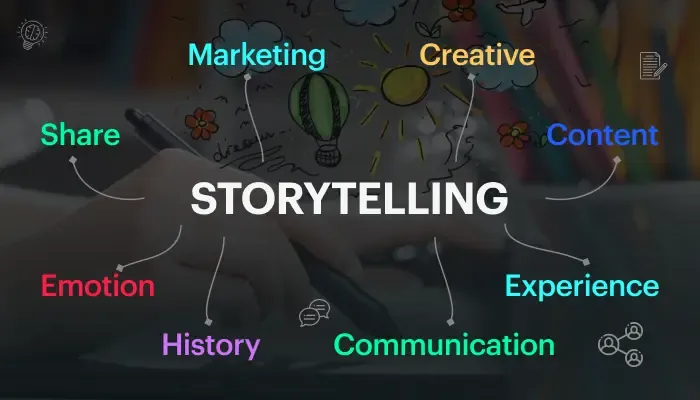Introduction: The Art and Craft of Storytelling in Design
The dawning of the digital age has significantly changed the landscape of design. We've evolved from being mere passive spectators of design to actively engaging in rich, interactive experiences that elicit emotional responses.
This shift can be attributed to one powerful concept: storytelling in design. This art of creating captivating narratives that weave together the fabric of user experience (UX) has become a cornerstone of good design practice.

II. Storytelling in Design: Understanding Its Power and Importance
Stories are the lifeblood of human communication. They bring color to our conversations, depth to our interactions, and help us make sense of the world around us. Applying this timeless tool in design has taken the user experience to an unprecedented level.
Storytelling in design adds an emotional dimension to the user journey. It infuses a design with a soul, making it more than just an interactive interface. When users engage with a design, they are not just users anymore; they become protagonists in a narrative that the design weaves around their interaction.

III. The Golden Thread: Weaving Storytelling into User Experience Design
In UX design, storytelling takes the spotlight. It isn't a passive, one-directional narrative but an interactive one. It puts the user in the driver's seat, letting them steer the story as they navigate the interface. Every element in the design becomes a plot point, shaping the user's journey.
For instance, an onboarding experience can be transformed from a generic welcome to a personalised adventure, using story elements. The application walkthrough can be designed as a quest, with the user learning and conquering challenges as they progress.

IV. The Unspoken Dialogue: Storytelling vs Basic Communication in Design
While essential communication focuses on the 'what' of the interface, storytelling emphasizes the 'why.' Here's how they differ:
- Connection: Basic communication aims to provide information. On the other hand, storytelling cultivates an emotional connection with the user. It adds context and meaning to the design, making it relatable.
- Memorability: Storytelling leaves a lasting impression on the user. A compelling narrative is more likely to be remembered than a list of disjointed facts.
- Differentiation: In a world saturated with products, storytelling offers differentiation opportunities. It helps a brand stand out and connect with its audience on a deeper level.

V. Mastering the Art: How Apple Uses Storytelling for Exceptional User Experience
One of the finest examples of storytelling in design is Apple. The tech giant doesn't sell products; it sells experiences.
Take the introduction of the iPod. While competitors were boasting about technical specifications, Apple launched its campaign with the '1,000 songs in your pocket' tagline. The narrative wasn't about the product but the experience it provided: limitless music at your fingertips, anytime, anywhere.
This narrative transformed the iPod from just another music player to a symbol of freedom, individuality, and revolution in music consumption. The resulting user experience was not about using a device but participating in a cultural shift.

VI. Pioneering the Future: Interactive Storytelling in UX Design
As we step into the future, storytelling in UX design is taking an interactive turn. This concept has been popularized by platforms like Netflix, with shows like 'Black Mirror: Bandersnatch,' offering viewers the chance to dictate the story.
In UX design, interactive storytelling could manifest as branching narratives, where the user’s decisions dictate the course of the story. This element of choice heightens user engagement, as they are not merely observers but active participants influencing the narrative.
VII. Conclusion: Embracing Storytelling as a Power Tool for UX Design
Storytelling in UX design is a potent tool, offering designers a unique way to elevate the user experience. Putting the user at the heart of a narrative personalizes the interface, making it more engaging and satisfying.
By bringing storytelling to the forefront of design, we can create more than just interfaces - we craft experiences. As designers, our challenge lies not only in making our designs visually appealing but also in making them emotionally captivating.
Frequently Asked Questions on Storytelling in UX Design
Q.1 Why is storytelling important in design?
Q.1 Why is storytelling important in design?
Ans: Storytelling breathes life into the design. It adds an emotional dimension, creating a deeper connection with the user. This enhanced connection can lead to increased user satisfaction and loyalty.
Q.2 How can designers incorporate storytelling into their designs?
Ans: Designers can incorporate storytelling by focusing on the user’s journey. Using characters, context, and conflict can create an engaging narrative that enhances the user experience.
Q.3 How does storytelling enhance UX/UI Design?
Ans: Storytelling makes UX/UI design more engaging and user-centric. It personalizes the user experience, making the interface more intuitive and memorable.
Q.4 How can storytelling improve my design?
Ans: Storytelling can bring your design to life. By crafting a narrative around the user’s journey, you can create an emotionally resonant experience, enhancing user satisfaction and brand loyalty.

